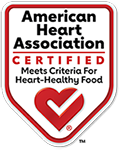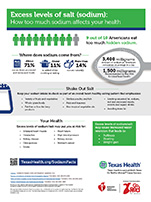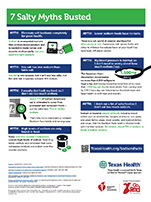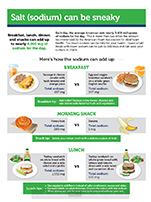Sodium: Get the Facts
Sodium is an essential nutrient for good health. It plays a role in blood pressure and allows your muscles and nerves to work properly. It also regulates fluid levels in your body to prevent dehydration.
On average, American adults eat more than 3,400 milligrams of sodium daily. That’s more than double the American Heart Association’s (AHA’s) recommended limit of 1,500 milligrams for ideal heart and cardiovascular health.
Is Sodium or Salt the Culprit?
While the terms sodium and salt are often used interchangeably, they are not the same. Sodium chloride is the chemical name for dietary salt. Most of the sodium we eat is in the form of salt, which can lead to some confusion. You may see both terms used on food packaging; for example, a product’s nutrition label may specify “sodium,” whereas the front of the package may say “salt free.”
You can find the amount of sodium in a food item by looking at the Nutrition Facts label. The amount of sodium per serving is listed in milligrams (or mg). The total sodium shown on the Nutrition Facts label includes the sodium from salt plus other ingredients like sodium nitrate, sodium citrate, monosodium glutamate (MSG) or sodium benzoate.
The AHA says a teaspoon of table salt has about 2,300 mg of sodium. An overindulgence in sodium/salt can increase water retention in the body and lead to puffiness, bloating and weight gain. You might be able to live with these inconveniences, but what about the risk of high blood pressure, heart failure or stroke?

“Excess levels of sodium/salt in your diet can put you at risk for developing one or more of these serious health conditions,” explains internist Sandip Mehta, D.O., FACOI, of Texas Health Adult Care, a Texas Health Physicians Group practice in Bedford. “When you eat too many salty foods, excess fluid starts to build up in your bloodstream. Salt causes your cardiovascular system to retain the excess fluid that your kidneys can’t filter, so it stays in your blood vessels causing hypertension. Over time, this high blood pressure can lead to heart disease, stroke and even kidney disease.”
“The frustrating problem for many people is not being able to recognize what too much sodium or salt looks like in the grocery store and at the table to make good strides in lowering their intake,” he adds.
One reason it can be difficult to shake the sodium/salt habit is because of sneaky sodium, says Mehta. “Sodium can hide in everything from your favorite pizza to sandwiches — places you may not think of as high in salt.”
Look for the Heart Check
 Learning to read and understand food labels can help you make healthier food choices. Start by looking for the AHA’s Heart Check mark on food packaging to find products that are healthier for your heart and other organs. And, get to know what sodium looks like in your diet. More than 40 percent of sodium comes from just 9 types of foods. These foods can be high in sneaky sodium even if they don’t taste salty:
Learning to read and understand food labels can help you make healthier food choices. Start by looking for the AHA’s Heart Check mark on food packaging to find products that are healthier for your heart and other organs. And, get to know what sodium looks like in your diet. More than 40 percent of sodium comes from just 9 types of foods. These foods can be high in sneaky sodium even if they don’t taste salty:
- Deli meat sandwiches
- Pizza
- Burritos and tacos
- Soups
- Savory snacks (including chips, crackers and popcorn)
- Poultry
- Pasta mixed dishes
- Burgers
- Egg dishes and omelets
“Foods that contain notably high amounts of sodium can actually fragilize a person’s health, and have a snowball effect,” Mehta says. “Because these foods are also high in saturated fat, they increase total cholesterol and bad cholesterol (LDL). Saturated fats have been shown to cause insulin resistance that may lead to prediabetes or worsening diabetes. When these foods are decreased or eliminated from a person’s diet, their total cholesterol and bad cholesterol go down, plus their blood glucose levels improve for total improvement in diabetes control. A bonus benefit is weight loss without going on a diet.”
“Knowledge is power when it comes to eating a healthy diet. I help patients simplify what a whole-body healthy diet can look like by providing them with an easy-to-understand food metric that quantifies sodium content on food labels. As a result, many of my patients have been able to eliminate foods that we know contributes to high blood pressure. Instead of adding medication to their care plan, they find a better way to a healthier heart by subtraction: decreasing or eliminating sneaky-sodium foods from their everyday diet.”
Should You Eliminate the Salt Shaker?
It’s not a bad idea. Frustratingly, the major portion of added sodium and salt Americans consume come from packaged, processed and restaurant foods rather than home recipes and fresh items.
Mehta says checking nutrition labels is the only way to know how much sodium is in your food. “It’s wise to choose foods that are labeled sodium-free or low sodium if you’re buying packaged or processed foods. And follow the serving size. If you eat more than the listed serving size, you’ll end up consuming much more sneaky sodium or salt than you intended.”
To trick your taste buds into thinking they’re getting the right amount of sodium/salt, use herbs, spices, citrus juice, vinegars and even vegetables such as garlic, onions and shallots to flavor food without the extra sodium.
“It’s best to choose wisely, read nutrition labels and watch portion control to show your heart some love. Avoiding foods with sneaky sodium improves your blood pressure, cholesterol, glucose and weight. All by subtraction!” Mehta adds.
Find out how healthy your heart is by taking our heart health assessment or learn more tips on staying ahead of heart disease.





